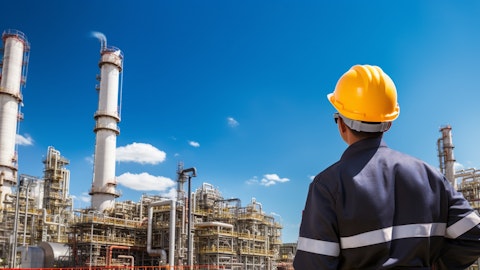Antero Resources Corporation (NYSE:AR) Q1 2025 Earnings Call Transcript May 1, 2025
Operator: Greetings, and welcome to the Antero Resources First Quarter 2025 Earnings Conference Call. [Operator Instructions]. As a reminder, this conference is being recorded. It is now my pleasure to introduce your host, Brendan Krueger, Vice President of Finance. Thank you, sir. You may begin.
Brendan Krueger: Thank you, and good morning. Thank you for joining us for Antero’s first quarter 2025 investor conference call. We’ll spend a few minutes going through the financial and operating highlights, and then we’ll open it up for Q&A. I would also like to direct you to the homepage of our website at www.anteroresources.com, where we have provided a separate earnings call presentation that will be reviewed during today’s call. Today’s call may contain certain non-GAAP financial measures. Please refer to our earnings press release for important disclosures regarding such measures, including reconciliations to the most comparable GAAP financial measures. Joining me on the call today are Paul Rady, Chairman, CEO and President; Michael Kennedy, CFO; Dave Cannelongo, Senior Vice President of Liquids Marketing and Transportation, and Justin Fowler, Senior Vice President of Natural Gas Marketing. I will now turn the call over to Paul.
Paul Rady: Thanks, Brendan, and good morning, everyone. Well, this year is off to an excellent start. Let me begin with Slide 3 titled Drilling and Completion Efficiencies, which details the drivers behind our exceptional performance during the first quarter. Starting with the chart on the left side of the slide, we increased our completed feet per day to an average of 2,452 feet. This represents an increase of 15% from the 2,140 feet per day average in 2023. On the right side of the slide, we highlight our completion stages per day. During the first quarter, we averaged 12.3 completion stages per day. This continues the upward trend when comparing to our performance the past two years. Notably, we set a new company record in the first quarter, achieving 18 completion stages per day on 1 pad in March.
Lastly, shown in the yellow bars of both charts we included recent records announced by our natural gas peers to provide context on just how efficient our Drilling and Completion teams are today. This performance allows us to run a very lean program with just two rigs on average and just over one completion crew on average in order to hold flat 3.4 Bcf equivalent per day of production. Now let’s turn to Slide 4 to discuss our updated hedges. During the quarter, we added new wide natural gas collars for 2026. The volumes hedged tied to the expected volumes from our Lean Gas development, which is the leaner Btu, so approximately 1,200 Btu or less that is planned through the end of 2026. These wide collars lock in attractive rates of return with a floor price of $3.07 and a ceiling of $5.96.
Hedging these lean gas pads allows for continuity in our development planning, which is essential to maintaining our capital efficiencies. With these new hedges in place, we have hedged approximately 9% of our expected natural gas volumes through 2026. Now to touch on the current Liquids and NGL fundamentals, I’m going to turn it over to our Senior Vice President of Liquids Marketing and Transportation; Dave Cannelongo for his comments.
Dave Cannelongo: Thanks, Paul. Let’s start on Slide 5 titled NGL Pricing Premium. Antero’s fundamental NGL position and pricing outlook remains strong. This strength is highlighted by our previously stated guidance for $1.50 to $2.50 per barrel premium to Mont Belvieu on our realized C3+ NGL prices. This expected premium is an improvement to the $1.41 per barrel premium that we achieved in 2024. Our outlook is supported by the strategic decision we made to enter into firm sales agreements on 90% of our LPG volumes for 2025 at double-digit cent per gallon premium to Mont Belvieu. In addition, selling our LPG at the Marcus Hook terminal along the East Coast has several competitive advantages. First, it is geographically advantaged to Europe and Atlantic Basin markets.
Second, we sell our LPG at the dock to the highest bidder, meaning the ultimate end destination does not directly impact us. And third, Marcus Hook export customers do not have cancellation rights. So the volumes that we have contracted to date are final. The result of these attributes is that regardless of the extent of current tariff negotiations, Antero’s marketing position and strategy helps limit any meaningful impact from the tariffs. Regarding our exposure to China, we did a look back at Antero’s historical LPG export cargoes and found that only two cargoes were directed by our customers to China during the entire year of 2024 or less than 4% of our overall C3+ NGL volumes. This year, no Antero volumes have gone to China to date, and none are contracted to do so for the remainder of the year.
As I just mentioned, we sell our LPG at the dock to customers offering the highest price. The fact that very few cargoes went to China going back to the beginning of 2024, even before the current trade policies went into effect, shows that the Chinese market is rarely the best bid for Antero’s barrels out of the East Coast. Next, I’d like to discuss our outlook for the global LPG market. First, I’ll note that there are recent reports suggesting that China is likely to exclude ethane and LPG from their tariffs, which is what they have done over the last five years. We’ll watch for updated developments there. Regardless, given how tight the global LPG supply-demand balance is, we anticipate that global trade patterns will adjust to absorb any displaced U.S. barrels.
A reshuffle of LPG trade flows could mean increased U.S. LPG volumes heading to Europe, Southeast Asia, India, Japan, South Korea. This would then require increased Middle Eastern, Russian and African LPG supplies to be directed into China. Global ship tracking data is already demonstrating some of this reshuffle with increased flows from the U.S. into Japan and South Korea. Most market participants and consultants believe that U.S. LPG barrels can find sufficient markets outside of China in the event that escalated tariffs continue. In the broader LPG export market, we have not heard of any cancellations at the major U.S. Gulf Coast export terminals since the tariffs came into effect, and demand and pricing for our remaining volumes in 2025 has remained essentially unchanged from prior months.

Slide 6 highlights U.S. propane exports. As you can see, exports year-to-date, including the most recent weeks in April are at record high levels and 7% above the year ago period, providing additional proof that we have not seen any impact to U.S. propane demand. With that, I’ll now turn it over to our Senior Vice President of Natural Gas Marketing, Justin Fowler, to discuss the natural gas market.
Justin Fowler: Thanks, Dave. I’ll start on Slide 7, which illustrates the positive impact on Gulf Coast pricing that we’ve experienced due to the faster-than-expected ramp of Venture Global Plaquemines LNG facility. The chart at the top of the slide illustrates the pace at which Plaquemines ramped up, as compared to Venture Global’s last LNG facility, Calcasieu Pass. The faster-than-anticipated start-up led to higher demand along our TGP 500L firm transport and therefore, higher pricing. Looking at the TGP 500L basis, which is the basis hub with the largest exposure to Plaquemines, the quicker than anticipated ramp of the facility has already lifted balance of the year 2025 and calendar 2026 pricing by $0.11 per MMBtu compared to strip pricing before the start-up.
Today, the facility is exporting an average of over 2.1 Bcf per day. Venture Global has indicated that they anticipate this increasing toward 2.7 Bcf per day in the coming months as the facility continues to commission additional blocks. As a reminder, Antero has 570 MMcf per day of firm transportation or approximately 25% of our gas production on the TGP 500L pool. Next, I’d like to turn to Slide 8 titled AR Positioned for Data Center Natural Gas Demand Surge. The Appalachian region in vicinity have quickly become a focal point for natural gas-fired power generation, data centers and behind the meter projects. These projects will require a significant amount of natural gas supply for decades. The extensive resource base of the Marcellus and Utica Shales provides certainty of long-term natural gas supply while supportive state regulations are leading to fast approvals and attractive incentives to build in the region.
Two recent announcements include the Homer City Power Plant outside of Pittsburgh and the CPV Shay Power Plant located within our development footprint in Doddridge County, West Virginia. Combined, these two natural gas power plants will deliver over 6.5 gigawatts of power, driving a nearly 1.2 Bcf increase in regional natural gas demand. Staying in West Virginia this month, the legislature has passed the Microgrid Bill, an initiative championed by West Virginia Governor Patrick Morrisey. The bill aims to attract data centers into the state and incentivizes them to build self-sufficient on-site power generation. The bill was signed in the law by the Governor just yesterday. Through our extensive resource base integrated midstream assets and firm transportation commitments to the Gulf Coast LNG corridor, we are uniquely positioned to participate in both the LNG export growth along the Gulf Coast and the expected growth in regional power demand through data center expansions.
Haynesville producers convention proximity to LNG, while Northeast producers can mention power exposure but Antero is the only company that is positioned for both. With that, I will turn it over to Mike Kennedy, CFO of Antero Resources.
Michael Kennedy: Thanks, Justin. In the first quarter, we executed on our plan, delivering production of 3.4 Bcfe per day at the midpoint of our guidance. Drilling and Completion capital was just $157 million or 23% of our full year guidance. We generated $337 million of free cash flow, which benefited from strong Natural Gas and NGL premiums relative to their benchmarks. We use this free cash flow to accelerate our share repurchase program, repurchasing $92 million of stock or nearly 1% of our shares outstanding year-to-date. In addition, we continue to focus on debt reduction, reducing debt by over $200 million during the first quarter. We entered 2025 in the strongest position in company history. Our low absolute debt and peer-leading capital efficiency provides us with flexibility and our shareholder return strategy.
With this flexibility, we can pivot between share buybacks or debt reduction depending on market conditions. This was highlighted by our activity year-to-date when we saw an opportunity between AR share value and market fundamentals and thus, we accelerated our buyback program ahead of the time line we had previously targeted. Let’s look at the attributes that put us in such a compelling position as we enter this new cycle. Starting with Slide 9 titled Leading Capital Efficiency and Free Cash Flow Breakeven Levels. The chart on the left-hand side of the slide highlights our capital efficiency relative to our peers. Antero has the lowest maintenance capital per Mcfe of its peer group at just $0.54 per Mcfe. This is 27% below the peer average of $0.74 per Mcfe.
The chart on the right shows unhedged free cash flow breakeven prices for Antero and our peer group. Antero has the lowest breakeven at $2.29 per Mcf, driven by our low maintenance capital requirements and our ability to capture premium pricing that both Dave and Justin detailed earlier. I’ll close my comments on Slide 10 titled Low Debt Balance Provides Flexibility. During the first quarter, we called the remaining $97 million of our 2026 senior notes, pushing our nearest maturity out to 2029. At March 31, our total debt is just $1.3 billion, which is the lowest debt level among our peers. Based on today’s current strip, our guidance suggests substantial free cash flow in 2025 and beyond. While we will target a 50-50 debt reduction and share buyback strategy, we intend to remain opportunistic pending market fluctuations.
With that, I will now turn the call over to the operator for questions.
Q&A Session
Follow Antero Resources Corp (NYSE:AR)
Follow Antero Resources Corp (NYSE:AR)
Receive real-time insider trading and news alerts
Operator: Thank you. We will now be conducting a question-and-answer session. [Operator Instructions] One moment please, while we poll for questions. Thank you. Our first question comes from the line of Arun Jayaram with JPMorgan. Please proceed with your question.
Arun Jayaram: Yes, good morning, Dave. I wanted to see if you could maybe clarify the marketing agreement for LPGs. As you mentioned, 90% of your LPG volumes are locked in with firm sales at a double-digit cent per gallon premium to Mont Belvieu. So a couple of questions around that would be, does this reflect your total volumes or is that just your exported volumes, because as you know in your weeklies you continue to highlight an annual mix of 50% international versus domestic?
Dave Cannelongo: Yes, Arun, so that 90% that I was speaking to is our export volumes. But when you look at our domestic sales as well, those are all locked in essentially at a 90 plus percent level in addition to that. So really our entire C3+ barrel is in that high, over 90% locked in premiums to Belvieu for the year, which is why we felt so confident in the guidance range that we gave back in February.
Arun Jayaram: Is there a general cost to enter into these agreements? Or is it just you’re giving the surety supply hence you get those premiums?
Dave Cannelongo: Yes, on the domestic side, it’s very common for those to be term deals that people lock in on an annual basis. Typically that’s an April to March contract year. And then on the export side, as we’ve talked about in prior years, sometimes we take an approach where we go and term up a lot of the volumes. Other times we go into the spot market, we really try and be opportunistic with what we see as the fundamentals and try and make the right call that’s going to maximize the value. And you’ve kind of seen us do that. Three of the six years we’ve been on Mariner 2019, ’24 and ’25. We’ve, we’ve really kind of called those market dynamics directly and been able to optimize our price realization. So we took advantage of some strength that was in the market early in 2025 to lock in some strong premiums.
And obviously had we not done that, the spot market’s been much weaker here in the mid single digits. So just trying to make the right calls at the right times when the market provides those opportunities.
Arun Jayaram: Great. And maybe my follow-up for you Paul. There’s recently been some stepped up M&A as we think about some of the gas levered producers in U.S. shale. And we’re hearing about maybe some more deal potential as the year kind of plays on. So I wanted to see if you could talk a little bit about how you’re thinking about inorganic investment opportunities within U.S. shale?
Michael Kennedy: Yes, Arun, this is Mike. We have, obviously have a very strong organic leasing program that’s adding locations at less than a million dollars. I think you saw in the first quarter it was $850,000. We continue to lease those acres in and amongst and exactly right next to our current development. So as long as that’s available to us, that’s what M&A would have to compete with. And as I mentioned, our development program is so strong just because of our infrastructure, our midstream, our FT, everything we’ve talked about on today’s call. And it really is just developing that next pad over and it’s a contiguous acreage position, so any M&A would have to compete with that and that’s very much a challenge to see. In addition to that, you look at our inventory, it’s over 20 years, half of it’s liquid, half of it’s dry gas, next 10 years, liquids, after that, dry gas.
So we have substantial length in our inventory. So once again, there’s no real need to do M&A. If it’s ever opportunistic and very accretive to us and makes sense to us, of course we would look at it, but there’s no need for M&A for Antero.
Arun Jayaram: Great. Thanks a lot.
Operator: Our next question comes from the line of John Freeman with Raymond James. Please proceed with your question.
John Freeman: Thanks. Good morning, guys. I first wanted to touch base on the buybacks. As you highlighted, Mike, you all stepped into that earlier than sort of the original plan of sort of taking down the $500 million on the debt and then going to that kind of 50-50 debt reduction of buybacks. So I just want to make sure that I understood right, Mike, because right now is the plan now going forward that it’s going to be kind of the 50-50 sort of debt reduction versus buybacks from this point forward as opposed to waiting until the full $500 million had been taken down?
Michael Kennedy: Yes, John, yes, we’re opportunistic and we’re trying to be countercyclical. We didn’t think we’d get this opportunity to buy shares at these prices. I mean, when you look at our fundamental outlook, it’s as strong as ever. And to have the shares valued at where it is today is an opportunity for us. So that’s why we pivoted towards share buybacks. We have a lot of visibility into our business and our cash flow generation and we don’t really have any debt, so very little debt. No maturity until ’29. So we’ve never really been in this position where we can see our cash flow generation not be reflected in the market and so we’re able to capitalize on that, but the opportunity is more towards the debt side. We could pivot towards that, but at today’s stock levels and share and value levels, we pivoted towards this 50-50 strategy basically in March.
John Freeman: That’s great. Yes, that makes sense. The follow-up question just on the hedging strategy and y’all did sort of indicate y’all were moving this direction with maybe looking to do some collars and in 2026 and understand that they’re pretty wide collars. So you’re still getting to participate in the upside. But just want to have an idea is, should we expect that y’all would continue to increase that hedge percentage in 2026 or is this sort of more opportunistic or kind of one off or is this some sort of change in the hedging strategy that we should think about going forward?
Michael Kennedy: Yes, no change, so very bullish. We have four pads that were that lean gas that Paul mentioned. One’s on right now. One comes on in the third quarter and then two in the early part of ’26 that we talked about earlier needing really like 275 plus to really generate high returns for us. Never in our careers have we seen a future strip price with a four handle on it and you get a 2.2 or greater call skew on that. So to be able to lock in at $3 and I think today it’s $3 by $7 plus, that’s quite the dynamic to be able to lock in those returns on those pads, not have to have DUCs like we did last year, continue to produce those out at high returns, high cash flows and still have upside to 740. So we’re still very bullish. It’s just quite the dynamic for us with the call skew and the elevated pricing in ’26.
John Freeman: Thanks. Appreciate it.
Michael Kennedy: Thank you.
Operator: Our next question comes from the line of Doug Leggate with Wolfe Research. Please proceed with your question.
John Abbott: Good morning, this is John Abbott on for Doug Leggate. We want to start off going back to the capital returns here. I mean you accelerated the buyback earlier as mentioned on one of the previous questions, and you want to be opportunistic. So I guess the question is, you see the value in buying your shares now under the strategy, is there a point where you would probably not buy shares? You see — you’re just, in other words, you generate more cash at higher gas prices. So do you buy more shares or do you or do you conserve? Do you keep cash on the balance sheet? How do you think about that dynamic going forward for buybacks?
Michael Kennedy: Yes. No, we always see value in buying back our shares. Antero is a tremendous company. We’ll always want to be interested in buying back shares, but its common sense. What we found is when you’re countercyclical, that’s when you generate the highest returns and buying them back and then when your share price is at a high point or higher point. Buying down debt always accrues to the equity as well. So it’s kind of just a balance. You’re just trying to be opportunistic. Buy low when you can.
John Abbott: Appreciate it and appreciated the discussion during the opening remarks on the NGL macro, maybe a couple of questions with respect to NGLs, maybe with regards to your inventory. I mean, how would you sort of parse out the breakeven of your NGL inventory? I mean, not all acreage is sort of the same. Is there a point when you would reduce activity if you saw a certain NGL price? Is there a minimum level of activity that you would wish to maintain? How do you think of those dynamics? Granted, I understand you’re still –?
Michael Kennedy: Yes, you got to compare it to natural gas prices. So a good example is last year you averaged $2.27 natural gas NYMEX. But because C3+ liquids were in the 40s, we generated on an unhedged basis over $70 million of free cash flow. So that’s how our breakeven last year was at $2.20. We mentioned today’s comments $2.29 in the first quarter with the $40 C3+. Just looking in the out years right now, even with the backwardation of oil being in the high 50s and that would put C3+ in the low 30s at today’s natural gas strip, Antero is still generating a billion dollar plus free cash flow every year. So you got to compare to natural gas prices. Obviously there’s a dynamic there that if you have low oil prices and low C3+ prices, you’re probably going to have low associated gas and thus high natural gas prices.
That’s why Antero is so well-positioned, really has no constraints around infrastructure. We always talk about that transport midstream. But it’s also diversity of product. Being such a large natural gas producer and such a large liquids producer puts us in good shape with low debt, obviously.
John Abbott: Appreciate it. Thank you very much for taking our questions.
Michael Kennedy: Thanks Doug.
Operator: Our next question comes from the line of Kevin McCarthy with Pickering Energy Partners. Please proceed with your question.
Kevin McCarthy: Hey, good morning. My first question is more strategic. Some of your gas peers have announced well received plans to grow volumes. I know that you see a lot of potential in just running a maintenance program, but as you look out over the next 5 to 10 years, what are the market dynamics that would incentivize you to grow volumes? And is there any operational constraint in doing so?
Michael Kennedy: The market would be around what we talked about the local gas demand, those power plants that Justin highlighted, data centers, anything locally that where you flow our gas. I mean, we have over 1,000 dry gas locations that are well above 2 Bcf per 1,000 over in the eastern portion of our fields. We have ample inventory to grow. We have the local midstream capacity with Antero midstream. It’s really just if there’s that local demand, we’re not going to grow into basis — local basis without the demand meeting the need for the supply. So that’s what would be required if you have to make future commitments on FT or processing or whatnot. That’s not something we’re interested in. Our FT and processing are almost full right now. They actually are full or above nameplate on the processing. So that’s why we pursue maintenance capital. But if you did get local demand that demanded our gas, we could fill that very easily.
Kevin McCarthy: Great, thank you for that detail. And as a follow-up, another question on the LPG sales, you had the foresight to lock in the premiums for 2025 before the ARBs closed. But as you look into 2026, if there’s no pricing advantage to sell to either one of the international — either one or both of the international markets, what is your flexibility to sell volumes between the U.S. markets and international? Thanks.
Michael Kennedy: Yes, so I wouldn’t say the ARBs closed, it’s just come down a bit. I think what Dave mentioned is what we saw was pretty premium pricing for ’25 that more than matched our premium pricing in ’24 and we saw it in January. So our liquids departments very adept and very agile and so they were able to capture those premiums. When you can capture $0.15 premium versus what you average, maybe $0.11 in ’24 and lock that in, that was very attractive to us. And they really look at the export capacity of the U.S. If a new dock capacity is coming on, if the local production is going to meet that, there’s a lot of dynamics. So they do a great job and a really detailed and thorough analysis, probably the best in the business in doing that.
And so, we’ll do that same analysis and we do it on a daily basis, but we’ll continue to do that analysis throughout the year and then the ’26 and Dave mentioned it really goes till the end of March 31, 2026. So through the next year we’ll continue to analyze and we’ll make the proper decisions beginning of next year.
Kevin McCarthy: Thank you.
Operator: Our next question comes from the line of Leo Mariani with ROTH Capital Partners. Please proceed with your question.
Leo Mariani: I wanted to just follow up a little bit on the commentary around the split between debt pay down and buyback. Got the 50-50, very clear on that, but just in the first quarter, if I just look at the pure numbers, it’s just over $200 million of debt that you paid down and in the first quarter I think it was only a $10 million buyback. Obviously, you did some subsequently here in April to get to the 92, but on the 50-50 are you guys going to be looking at that kind of on a full year basis on the 50-50, because you obviously skewed much higher to get paid down in the first quarter, so just trying to get a sense if there’s more room for share buyback potentially this year? And obviously on the debt side you’ve got just over $300 million on your revolver left, so maybe not quite as much to pay down here in the near term.
Michael Kennedy: Yes, I think you saw the opportunistic. I mean, we looked at, just pulled it off the screen. We looked at the VWAP so far year to-date in Antero’s shares and we bought back at a 10% lower level than the average of our shares. We would have bought back earlier but there was no disconnect in the January and February price. All of a sudden in March I think you saw it across all markets. But uncertainty became apparent and so things became on sale. So we decided to capture that and then we put in a 10b5-1 plan to continue to buy throughout this. And so that’s what we’ll do going forward. Just being opportunistic. There’s no hard and fast rule 50-50. We could go more share buybacks if this continues, we could go less and pay down the debt a little bit more. But as you mentioned, we don’t have much debt left. So ultimately the share buybacks is going to be a greater and greater percentage of our free cash flow use.
Leo Mariani: Okay. Makes, makes a lot of sense for sure. And then obviously in your macro discussion you talked about potential for in-basin demand, rattled off a couple projects that have kind of been announced. Can you maybe provide a little bit more color on where Antero is in kind of the discussions to try to maybe capture some of this in-basin demand or some of these processes like a home or city, fairly competitive? Is there kind of a quote unquote auction for some of that type of supply? Maybe just can provide some more color on where Antero is on these projects?
Michael Kennedy: Well, Antero is obviously in the mix being one of the largest producers and definitely in West Virginia that CPV power plants right in the middle of our field. So we’ll have competitive advantages there. We’re not interested in selling our gas really at local basis. So, because right now, we obviously get Henry Hub and that’s where our gas goes. So, we do have a floor kind of on the pricing at least on our maintenance capital program, future growth, maybe in the coming years. Maybe that’s something that we would look at. But we’re really focused on our firm transport and getting the LPG right now. But we are having discussions with the local players, of course, because we are such a large producer.
Leo Mariani: Okay. Thank you.
Operator: Our next question comes from the line of Roger Read with Wells Fargo. Please proceed with your question.
Roger Read: Yes, thanks. Good morning.
Michael Kennedy: Hi, Roger.
Roger Read: I’m just sort of curious. I mean it sounds like, demand picked up a little quicker on the LNG side. No real change to your full year guidance. What would make you maybe a little more optimistic on the production side? And then also as a follow-up there to Leo’s question, just kind of thinking in-basin demand, where are you in terms of visibility on some of the improvements there?
Michael Kennedy: Well, we got a lot of visibility. We are the gas, The Liquids Producer in Appalachian. So a lot of visibility. But we’re pursuing the maintenance capital plan because that fills our firm transport, fills our processing and allows us to produce at the highest returns with the premium pricing from the NGLs and the natural gas. So no change to that. Like we mentioned, it would have to be substantial local demand, and we would — our supply would meet the timing of that demand and that’s not in this year, and we don’t see much for next year either. So it will be a maintenance capital during that timeframe. But anything post that, when we mentioned these projects, we could be a participant in those.
Roger Read: Okay, that’s it for me. I’ll turn it back. Thanks.
Michael Kennedy: All right. Thanks.
Operator: Our next question comes from the line of Paul Diamond with Citi. Please proceed with your question.
Paul Diamond: Good morning all. Thanks for taking the time. Just a quick one for me. Sticking on the in-basin demand dialogue. I know with all the FT — with all your FT on the books and maintenance capital pretty much filling that, I guess, trying to drill down a little bit on what type of pricing like in-basin, like what collapsed on the basis in Appalachian, would you need to see to actually like sign on to that? Is that your breakeven is plus X? Or is that more of like a solid number? How do you guys do that?
Michael Kennedy: Yes. No, we really view it through a NYMEX Henry Hub lens. I mean that’s how we’ve been talking about it, whether it’s ethane, other projects or natural gas because that’s what you can hedge for years and years and years. The basis could be strong at any particular moment. But in the shoulder months, summer months, you could see weakness. And so that’s why when you look out, you see pretty wide basis locally, even though there is very strong pricing in the first quarter. So it’s kind of more of a long-term look. Can you lock it in? Can you hedge it? Can you count on it? Can you spend billion dollars of capital to support it? That’s why we looked at. And that’s why everything we’ve got really prices off NYMEX Henry Hub.
Paul Diamond: Got it. So there’s the — I would guess, little expectation that there would be any sort of discount to Hub over the long term in order to get you guys to actually move.
Michael Kennedy: Yes. I mean you could have a contract that’s Henry Hub minus something, but it would have to be kind of floating on that Henry Hub, having a floating on a local basis. You can have such disconnects at certain times that it’s hard to put a lot of capital behind that.
Paul Diamond: That makes perfect sense. I’ll leave it there. Thanks for your time.
Operator: Our next question comes from the line of Neil Mehta with Goldman Sachs. Please proceed with your question.
Neil Mehta: Hi Tim, good morning. Just wanted to stay on the gas macro — the dry gas macro and get your perspective with lower oil prices, and we’ll see what happens here over the next couple of days. How you’re thinking about associated supply in the United States, particularly out of the Permian? And does that represent a tailwind that can make natural gas despite the risk potentially around industrial demand more protected from economic volatility?
Michael Kennedy: Yes, definitely. We’ve never really seen a better setup from a natural gas demand growth over the coming quarters, years versus supply. I mean you’re coming into this already with a low rig count, very low in the Haynesville and Appalachian and other natural gas basins. And if you put on top of that, Permian rigs coming off and no real associated gas growth from there or muted. I mean that just sets up for an explosive kind of natural gas environment going forward with the LPG — I mean with the LNG demand and kind of electrification of America supporting the demand side of things. So very exciting and definitely would be a tailwind for natural gas.
Neil Mehta: So two long-term questions as it relates to gas. I mean the bull side is we have to price to the Haynesville. I know you guys don’t have exposure there. I’m sure you’ve done a lot of work to try to benchmark what you think the marginal Haynesville cost would be if that’s the price-setting mechanism. Do you have a strong view on that? And then the offset for those who are more bearish, is the global gas market does slip. It seems like into decent oversupply. Does that provide a governor on how high we can ultimately go? And so is that even a relevant marker? Or do we have to price to TTF minus? So just thoughts around that.
Michael Kennedy: Yes. No, see — we think Haynesville is probably $4 plus, and that’s probably the inventory right now, and that runs out pretty quick. So I mean, no one really talks about inventory fatigue, but you’ll definitely see it across the basin. So all this gas supply is going to have to come from not your Appalachian low-cost producers. It’s going to come from ever-increasing second-tier acreage and second-tier basin. So that price will continue to go up.
Neil Mehta: In global gas, how do you think about that headwind on the other side?
Michael Kennedy: I don’t think of a headwind if it’s pricing of TTF. So we got Justin here, what’s the kind of the tolling and the shipping, if the arb goes to TTF? Is it TTF plus $3.50, TTF plus $4 or something like that. So…
Justin Fowler: Neil, it’s Justin. When we look on the longer data, balance of ’25 through call — ’28, call it spread still look very healthy to the European and Asian markets. So we feel like that those netbacks will support continued buying and growth. You continue to see FSRUs being set globally at multiple locations, various countries that are going to continue to consume natural gas because it is the fuel of the future here. So continuing to see that demand getting built out.
Michael Kennedy: Okay. Thanks Justin. Thanks team.
Justin Fowler: Thank you.
Operator: Our next question comes from the line of Betty Jiang with Barclays. Please proceed with your question.
Betty Jiang: Hello, good morning. Thank you for taking my question. I have a question back to the C3+ premium guidance. So if you guys are getting $0.15 per gallon premium on 90% of your export volume. So that equates to roughly $6 premium. Just trying to square that to your full year guidance of $2. Are you just assuming a bigger discount on the domestic volumes or that guidance could be conservative?
Michael Kennedy: That’s just on the exports. So — and on propane, the LPG has got a lot more in it, obviously, butane, natural gasoline, all that. So that’s just on the propane portion that is exported. And so when you sell it locally, it’s more like a Mont Belvieu price. So for the propane and then the butane and natural gasoline is not what that premium is. It’s not near that $0.15.
Betty Jiang: Got it. $0.15 just on propane piece…
Michael Kennedy: On the export propane, yes.
Betty Jiang: Got it. And then separately on the GP&T, could you maybe talk about some of the disruptions or dynamic for 1Q? And also follow-up on the comment earlier about processing plants running full and running above nameplate. How does that translate to your liquids mix over time? Do you see your C3+ mix much above 20% longer term?
Michael Kennedy: So if you read the AM, Antero Midstream release, you saw that our processing was more than full. I think it was like 104% or something like that, on the Sherwood and Smithburg processing facility. So you can see there, there wouldn’t be any change to our current mix of liquids. Then on your GP&T, remember, there’s a variable component on natural gas prices as they go higher. We do have transport expense, fuel expense on the transport and taxes. So our general rule of thumb is for every dollar of natural gas price higher, you get $0.10 higher variable price on the GP&T. So that’s why you saw it a little bit higher than our guidance range. It comes back down throughout the year as you have a little bit lower pricing in the second and third quarter.
Betty Jiang: Got it. That’s helpful. Thank you.
Michael Kennedy: Sure. Thank you.
Operator: We have reached the end of the question-and-answer session. I would now like to turn the floor back over to management for closing comments.
Brendan Krueger: Yes. Thank you for joining us on today’s call. Please reach out with any further questions. Thank you.
Operator: Ladies and gentlemen, this does conclude today’s teleconference. You may disconnect your lines at this time. Thank you for your participation, and have a wonderful day.
Follow Antero Resources Corp (NYSE:AR)
Follow Antero Resources Corp (NYSE:AR)
Receive real-time insider trading and news alerts





